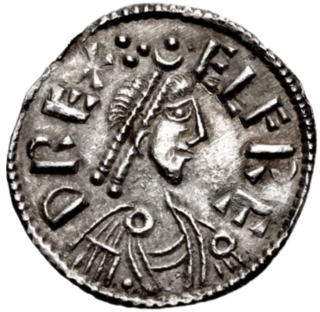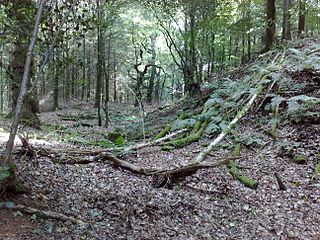
Alfred the Great was King of the West Saxons from 871 to 886, and King of the Anglo-Saxons from 886 until his death in 899. He was the youngest son of King Æthelwulf and his first wife Osburh, who both died when Alfred was young. Three of Alfred's brothers, Æthelbald, Æthelberht and Æthelred, reigned in turn before him. Under Alfred's rule, considerable administrative and military reforms were introduced, prompting lasting change in England.

The Kingdom of the West Saxons, also known as the Kingdom of Wessex, was an Anglo-Saxon kingdom in the south of Great Britain, from around 519 until Alfred the Great declared himself as King of the Anglo-Saxons in 886.

South West England, or the South West of England, is one of the nine official regions of England in the United Kingdom. It consists of the counties of Cornwall, Dorset, Devon, Bristol, Gloucestershire, Somerset and Wiltshire. Cities and large towns in the region include Bath, Bristol, Bournemouth, Cheltenham, Exeter, Gloucester, Plymouth and Swindon. It is geographically the largest of the nine regions of England with a land area of 9,203 square miles (23,836 km2), but the third-least populous, with an estimated 5,764,881 residents in 2022.

The Danelaw was the part of England between the early tenth century and the Norman Conquest under Anglo-Saxon rule in which Danish laws applied. The Danelaw originated in the conquest and occupation of large parts of eastern and northern England by Danish Vikings in the late ninth century. The term applies to the areas in which English kings allowed the Danes to keep their own laws following the tenth-century English conquest in return for the Danish settlers' loyalty to the English crown. "Danelaw" is first recorded in the early 11th century as Dena lage.

The Battle of Brunanburh was fought in 937 between Æthelstan, King of England, and an alliance of Olaf Guthfrithson, King of Dublin; Constantine II, King of Scotland; and Owain, King of Strathclyde. The battle is sometimes cited as the point of origin for English national identity: historians such as Michael Livingston argue that "the men who fought and died on that field forged a political map of the future that remains, arguably making the Battle of Brunanburh one of the most significant battles in the long history not just of England, but of the whole of the British Isles."

At the Battle of Edington, an army of the kingdom of Wessex under Alfred the Great defeated the Great Heathen Army led by the Dane Guthrum sometime between 6 and 12 May 878, resulting in the Treaty of Wedmore later the same year. Primary sources locate the battle at "Eðandun". Until a scholarly consensus linked the battle site with the present-day village of Edington in Wiltshire, it was known as the Battle of Ethandun. This name continues to be used.
Dumnonia is the Latinised name for a Brythonic kingdom that existed in Sub-Roman Britain between the late 4th and late 8th centuries CE in the more westerly parts of present-day South West England. It was centred in the area of modern Devon, but also included modern Cornwall and part of Somerset, with its eastern boundary changing over time as the gradual westward expansion of the neighbouring Anglo-Saxon kingdom of Wessex encroached on its territory. The spelling Damnonia is sometimes encountered, but that spelling is also used for the land of the Damnonii, later part of the Kingdom of Strathclyde, in present-day southern Scotland. The form Domnonia also occurs. The name of the kingdom shares a linguistic relationship with the Breton region of Domnonée.

Devon is a county in south west England, bordering Cornwall to the west with Dorset and Somerset to the east. There is evidence of occupation of the county from the Stone Age onwards. Its recorded history starts in the Roman period, when it was a civitas. It was then a separate kingdom for a number of centuries until it was incorporated into early England. It has remained a largely agriculture-based region ever since, though tourism is now very important.
The Reverend Charles Watts Whistler MRCS, LSA, was an English writer of historical fiction, who set his work between 600 and 1100 CE, usually based on early Saxon chronicles, Norse or Danish sagas and archaeological discoveries.

The Battle of Peonnum was fought about AD 660 between the West Saxons under Cenwalh and the Britons of what is now Somerset in England. It was a decisive victory for the Saxons, who gained control of Somerset as far west as the River Parrett. The location of the battle is uncertain.

Pinhoe is a former village, manor and ecclesiastical parish, now a suburb on the north eastern outskirts of the City of Exeter in the county of Devon, England. The 2001 census recorded a population of 6,108 people resident within Pinhoe Ward, one of 18 wards comprising the City of Exeter. The population increased to 6,454 at the 2011 Census.
The First Battle of Alton was a skirmish in 1001 between the English and the Vikings. According to the Anglo-Saxon Chronicle it took place at somewhere called, in Old English, Æthelingadene. Traditionally, the site was believed to have been what is now Alton, Hampshire. However, it is thought more likely to have been in the East and West Dean area of modern-day West Sussex.

This timeline summarizes significant events in the History of Cornwall
Events from the 1000s in England.

The siege of Exeter occurred early in 1068 when King William I of England marched a combined army of Normans and loyal Englishmen westwards to force the submission of the city of Exeter in Devon, a stronghold of Anglo-Saxon resistance against Norman rule following the Norman conquest of England. After a siege lasting eighteen days, the city surrendered to William under generous terms and allowed the Normans to consolidate their hold over the West Country.

Various monasteries and other religious houses have existed at various times during the Middle Ages in the city of Exeter, Devon, England.
The Battle of Buttington was fought in 893 between a Viking army and an alliance of Anglo-Saxons and Welsh.

The Battle of Hingston Down took place in 838, probably at Hingston Down in Cornwall between a combined force of Cornish and Vikings on the one side, and West Saxons led by Ecgberht, King of Wessex on the other. The result was a West Saxon victory. According to the Anglo-Saxon Chronicle, which called the Cornish the West Welsh:
Odda, also known as Oddune, was a ninth-century ealdorman of Devon. He is known for his victory at the Battle of Cynwit in 878, where his West Saxon forces defeated a Viking army led by Ubba, brother of the Viking chiefs Ivar the Boneless and Halfdan Ragnarsson.
The Battle of Chippenham was a January 878 battle between a Viking army led by Guthrum and an Anglo-Saxon army led by Alfred the Great. The Vikings forced Alfred to flee Chippenham and managed temporarily to gain control over most of Wessex.











